
Volume XIV, Issue XVII
From the Earth to the Moon
By Jules Verne
CHAPTER V, THE ROMANCE OF THE MOON
An observer endued with an infinite range of vision, and placed in that unknown center around which the entire world revolves, might have beheld myriads of atoms filling all space during the chaotic epoch of the universe. Little by little, as ages went on, a change took place; a general law of attraction manifested itself, to which the hitherto errant atoms became obedient: these atoms combined together chemically according to their affinities, formed themselves into molecules, and composed those nebulous masses with which the depths of the heavens are strewed. These masses became immediately endued with a rotary motion around their own central point. This center, formed of indefinite molecules, began to revolve around its own axis during its gradual condensation; then, following the immutable laws of mechanics, in proportion as its bulk diminished by condensation, its rotary motion became accelerated, and these two effects continuing, the result was the formation of one principal star, the center of the nebulous mass.
By attentively watching, the observer would then have perceived the other molecules of the mass, following the example of this central star, become likewise condensed by gradually accelerated rotation, and gravitating round it in the shape of innumerable stars. Thus was formed the Nebulae, of which astronomers have reckoned up nearly 5,000.
Among these 5,000 nebulae there is one which has received the name of the Milky Way, and which contains eighteen millions of stars, each of which has become the center of a solar world.
If the observer had then specially directed his attention to one of the more humble and less brilliant of these stellar bodies, a star of the fourth class, that which is arrogantly called the Sun, all the phenomena to which the formation of the Universe is to be ascribed would have been successively fulfilled before his eyes. In fact, he would have perceived this sun, as yet in the gaseous state, and composed of moving molecules, revolving round its axis in order to accomplish its work of concentration. This motion, faithful to the laws of mechanics, would have been accelerated with the diminution of its volume; and a moment would have arrived when the centrifugal force would have overpowered the centripetal, which causes the molecules all to tend toward the center.
Another phenomenon would now have passed before the observer's eye, and the molecules situated on the plane of the equator, escaping like a stone from a sling of which the cord had suddenly snapped, would have formed around the sun sundry concentric rings resembling that of Saturn. In their turn, again, these rings of cosmical matter, excited by a rotary motion about the central mass, would have been broken up and decomposed into secondary nebulosities, that is to say, into planets. Similarly he would have observed these planets throw off one or more rings each, which became the origin of the secondary bodies which we call satellites.
Thus, then, advancing from atom to molecule, from molecule to nebulous mass, from that to principal star, from star to sun, from sun to planet, and hence to satellite, we have the whole series of transformations undergone by the heavenly bodies during the first days of the world.
Now, of those attendant bodies which the sun maintains in their elliptical orbits by the great law of gravitation, some few in turn possess satellites. Uranus has eight, Saturn eight, Jupiter four, Neptune possibly three, and the Earth one. This last, one of the least important of the entire solar system, we call the Moon; and it is she whom the daring genius of the Americans professed their intention of conquering.
The moon, by her comparative proximity, and the constantly varying appearances produced by her several phases, has always occupied a considerable share of the attention of the inhabitants of the earth.
From the time of Thales of Miletus, in the fifth century B.C., down to that of Copernicus in the fifteenth and Tycho Brahe in the sixteenth century A.D., observations have been from time to time carried on with more or less correctness, until in the present day the altitudes of the lunar mountains have been determined with exactitude. Galileo explained the phenomena of the lunar light produced during certain of her phases by the existence of mountains, to which he assigned a mean altitude of 27,000 feet. After him Hevelius, an astronomer of Dantzic, reduced the highest elevations to 15,000 feet; but the calculations of Riccioli brought them up again to 21,000 feet.
At the close of the eighteenth century Herschel, armed with a powerful telescope, considerably reduced the preceding measurements. He assigned a height of 11,400 feet to the maximum elevations, and reduced the mean of the different altitudes to little more than 2,400 feet. But Herschel's calculations were in their turn corrected by the observations of Halley, Nasmyth, Bianchini, Gruithuysen, and others; but it was reserved for the labors of Boeer and Maedler finally to solve the question. They succeeded in measuring 1,905 different elevations, of which six exceed 15,000 feet, and twenty-two exceed 14,400 feet. The highest summit of all towers to a height of 22,606 feet above the surface of the lunar disc. At the same period the examination of the moon was completed. She appeared completely riddled with craters, and her essentially volcanic character was apparent at each observation. By the absence of refraction in the rays of the planets occulted by her we conclude that she is absolutely devoid of an atmosphere. The absence of air entails the absence of water. It became, therefore, manifest that the Selenites, to support life under such conditions, must possess a special organization of their own, must differ remarkably from the inhabitants of the earth.
At length, thanks to modern art, instruments of still higher perfection searched the moon without intermission, not leaving a single point of her surface unexplored; and notwithstanding that her diameter measures 2,150 miles, her surface equals the one-fifteenth part of that of our globe, and her bulk the one-forty-ninth part of that of the terrestrial spheroid-- not one of her secrets was able to escape the eyes of the astronomers; and these skillful men of science carried to an even greater degree their prodigious observations.
Thus they remarked that, during full moon, the disc appeared scored in certain parts with white lines; and, during the phases, with black. On prosecuting the study of these with still greater precision, they succeeded in obtaining an exact account of the nature of these lines. They were long and narrow furrows sunk between parallel ridges, bordering generally upon the edges of the craters. Their length varied between ten and 100 miles, and their width was about 1,600 yards. Astronomers called them chasms, but they could not get any further. Whether these chasms were the dried-up beds of ancient rivers or not they were unable thoroughly to ascertain.
The Americans, among others, hoped one day or other to determine this geological question. They also undertook to examine the true nature of that system of parallel ramparts discovered on the moon's surface by Gruithuysen, a learned professor of Munich, who considered them to be "a system of fortifications thrown up by the Selenitic engineers." These two points, yet obscure, as well as others, no doubt, could not be definitely settled except by direct communication with the moon.
Regarding the degree of intensity of its light, there was nothing more to learn on this point. It was known that it is 300,000 times weaker than that of the sun, and that its heat has no appreciable effect upon the thermometer.
As to the phenomenon known as the "ashy light," it is explained naturally by the effect of the transmission of the solar rays from the earth to the moon, which give the appearance of completeness to the lunar disc, while it presents itself under the crescent form during its first and last phases.
Such was the state of knowledge acquired regarding the earth's satellite, which the Gun Club undertook to perfect in all its aspects, cosmographic, geological, political, and moral.
CHAPTER VI,
PERMISSIVE LIMITS OF IGNORANCE AND BELIEF IN THE UNITED STATES
The immediate result of Barbicane's proposition was to place upon the orders of the day all the astronomical facts relative to the Queen of the Night. Everybody set to work to study assiduously. One would have thought that the moon had just appeared for the first time, and that no one had ever before caught a glimpse of her in the heavens. The papers revived all the old anecdotes in which the "sun of the wolves" played a part; they recalled the influences which the ignorance of past ages ascribed to her; in short, all America was seized with selenomania, or had become moon-mad.
The scientific journals, for their part, dealt more especially with the questions which touched upon the enterprise of the Gun Club. The letter of the Observatory of Cambridge was published by them, and commented upon with unreserved approval.
Until that time most people had been ignorant of the mode in which the distance which separates the moon from the earth is calculated. They took advantage of this fact to explain to them that this distance was obtained by measuring the parallax of the moon. The term parallax proving "caviare to the general," they further explained that it meant the angle formed by the inclination of two straight lines drawn from either extremity of the earth's radius to the moon. On doubts being expressed as to the correctness of this method, they immediately proved that not only was the mean distance 234,347 miles, but that astronomers could not possibly be in error in their estimate by more than seventy miles either way.
To those who were not familiar with the motions of the moon, they demonstrated that she possesses two distinct motions, the first being that of rotation upon her axis, the second being that of revolution round the earth, accomplishing both together in an equal period of time, that is to say, in twenty-seven and one-third days.
The motion of rotation is that which produces day and night on the surface of the moon; save that there is only one day and one night in the lunar month, each lasting three hundred and fifty-four and one-third hours. But, happily for her, the face turned toward the terrestrial globe is illuminated by it with an intensity equal to that of fourteen moons. As to the other face, always invisible to us, it has of necessity three hundred and fifty-four hours of absolute night, tempered only by that "pale glimmer which falls upon it from the stars."
Some well-intentioned, but rather obstinate persons, could not at first comprehend how, if the moon displays invariably the same face to the earth during her revolution, she can describe one turn round herself. To such they answered, "Go into your dining-room, and walk round the table in such a way as to always keep your face turned toward the center; by the time you will have achieved one complete round you will have completed one turn around yourself, since your eye will have traversed successively every point of the room. Well, then, the room is the heavens, the table is the earth, and the moon is yourself." And they would go away delighted.
So, then the moon displays invariably the same face to the earth; nevertheless, to be quite exact, it is necessary to add that, in consequence of certain fluctuations of north and south, and of west and east, termed her libration, she permits rather more than half, that is to say, five-sevenths, to be seen.
As soon as the ignoramuses came to understand as much as the director of the observatory himself knew, they began to worry themselves regarding her revolution round the earth, whereupon twenty scientific reviews immediately came to the rescue. They pointed out to them that the firmament, with its infinitude of stars, may be considered as one vast dial-plate, upon which the moon travels, indicating the true time to all the inhabitants of the earth; that it is during this movement that the Queen of Night exhibits her different phases; that the moon is full when she is in opposition with the sun, that is when the three bodies are on the same straight line, the earth occupying the center; that she is new when she is in conjunction with the sun, that is, when she is between it and the earth; and, lastly that she is in her first or last quarter, when she makes with the sun and the earth an angle of which she herself occupies the apex.
Regarding the altitude which the moon attains above the horizon, the letter of the Cambridge Observatory had said all that was to be said in this respect. Every one knew that this altitude varies according to the latitude of the observer. But the only zones of the globe in which the moon passes the zenith, that is, the point directly over the head of the spectator, are of necessity comprised between the twenty-eighth parallels and the equator. Hence the importance of the advice to try the experiment upon some point of that part of the globe, in order that the projectile might be discharged perpendicularly, and so the soonest escape the action of gravitation. This was an essential condition to the success of the enterprise, and continued actively to engage the public attention.
Regarding the path described by the moon in her revolution round the earth, the Cambridge Observatory had demonstrated that this path is a re-entering curve, not a perfect circle, but an ellipse, of which the earth occupies one of the foci. It was also well understood that it is farthest removed from the earth during its apogee, and approaches most nearly to it at its perigee.
Such was then the extent of knowledge possessed by every American on the subject, and of which no one could decently profess ignorance. Still, while these principles were being rapidly disseminated many errors and illusory fears proved less easy to eradicate. For instance, some worthy persons maintained that the moon was an ancient comet which, in describing its elongated orbit round the sun, happened to pass near the earth, and became confined within her circle of attraction. These drawing-room astronomers professed to explain the charred aspect of the moon-- a disaster which they attributed to the intensity of the solar heat; only, on being reminded that comets have an atmosphere, and that the moon has little or none, they were fairly at a loss for a reply.
Others again, belonging to the doubting class, expressed certain fears as to the position of the moon. They had heard it said that, according to observations made in the time of the Caliphs, her revolution had become accelerated in a certain degree. Hence they concluded, logically enough, that an acceleration of motion ought to be accompanied by a corresponding diminution in the distance separating the two bodies; and that, supposing the double effect to be continued to infinity, the moon would end by one day falling into the earth. However, they became reassured as to the fate of future generations on being apprised that, according to the calculations of Laplace, this acceleration of motion is confined within very restricted limits, and that a proportional diminution of speed will be certain to succeed it. So, then, the stability of the solar system would not be deranged in ages to come.
There remains but the third class, the superstitious. These worthies were not content merely to rest in ignorance; they must know all about things which had no existence whatever, and as to the moon, they had long known all about her. One set regarded her disc as a polished mirror, by means of which people could see each other from different points of the earth and interchange their thoughts. Another set pretended that out of one thousand new moons that had been observed, nine hundred and fifty had been attended with remarkable disturbances, such as cataclysms, revolutions, earthquakes, the deluge, etc. Then they believed in some mysterious influence exercised by her over human destinies-- that every Selenite was attached to some inhabitant of the earth by a tie of sympathy; they maintained that the entire vital system is subject to her control, etc. But in time the majority renounced these vulgar errors, and espoused the true side of the question. As for the Yankees, they had no other ambition than to take possession of this new continent of the sky, and to plant upon the summit of its highest elevation the star- spangled banner of the United States of America.
CHAPTER VII, THE HYMN OF THE CANNON-BALL
The Observatory of Cambridge in its memorable letter had treated the question from a purely astronomical point of view. The mechanical part still remained.
President Barbicane had, without loss of time, nominated a working committee of the Gun Club. The duty of this committee was to resolve the three grand questions of the cannon, the projectile, and the powder. It was composed of four members of great technical knowledge, Barbicane (with a casting vote in case of equality), General Morgan, Major Elphinstone, and J. T. Maston, to whom were confided the functions of secretary. On the 8th of October the committee met at the house of President Barbicane, 3 Republican Street. The meeting was opened by the president himself.
Gentlemen," said he, "we have to resolve one of the most important problems in the whole of the noble science of gunnery. It might appear, perhaps, the most logical course to devote our first meeting to the discussion of the engine to be employed. Nevertheless, after mature consideration, it has appeared to me that the question of the projectile must take precedence of that of the cannon, and that the dimensions of the latter must necessarily depend on those of the former."
Suffer me to say a word," here broke in J. T. Maston. Permission having been granted, "Gentlemen," said he with an inspired accent, "our president is right in placing the question of the projectile above all others. The ball we are about to discharge at the moon is our ambassador to her, and I wish to consider it from a moral point of view. The cannon-ball, gentlemen, to my mind, is the most magnificent manifestation of human power. If Providence has created the stars and the planets, man has called the cannon-ball into existence. Let Providence claim the swiftness of electricity and of light, of the stars, the comets, and the planets, of wind and sound-- we claim to have invented the swiftness of the cannon-ball, a hundred times superior to that of the swiftest horses or railway train. How glorious will be the moment when, infinitely exceeding all hitherto attained velocities, we shall launch our new projectile with the rapidity of seven miles a second! Shall it not, gentlemen-- shall it not be received up there with the honors due to a terrestrial ambassador?"
Overcome with emotion the orator sat down and applied himself to a huge plate of sandwiches before him.
And now," said Barbicane, "let us quit the domain of poetry and come direct to the question."
By all means," replied the members, each with his mouth full of sandwich.
The problem before us," continued the president, "is how to communicate to a projectile a velocity of 12,000 yards per second. Let us at present examine the velocities hitherto attained. General Morgan will be able to enlighten us on this point."
And the more easily," replied the general, "that during the war I was a member of the committee of experiments. I may say, then, that the 100-pounder Dahlgrens, which carried a distance of 5,000 yards, impressed upon their projectile an initial velocity of 500 yards a second. The Rodman Columbiad threw a shot weighing half a ton a distance of six miles, with a velocity of 800 yards per second-- a result which Armstrong and Palisser have never obtained in England."
This," replied Barbicane, "is, I believe, the maximum velocity ever attained?"
It is so," replied the general.
Ah!" groaned J. T. Maston, "if my mortar had not burst----"
Yes," quietly replied Barbicane, "but it did burst. We must take, then, for our starting point, this velocity of 800 yards. We must increase it twenty-fold. Now, reserving for another discussion the means of producing this velocity, I will call your attention to the dimensions which it will be proper to assign to the shot. You understand that we have nothing to do here with projectiles weighing at most but half a ton."
Why not?" demanded the major.
Because the shot," quickly replied J. T. Maston, "must be big enough to attract the attention of the inhabitants of the moon, if there are any?"
Yes," replied Barbicane, "and for another reason more important still."
What mean you?" asked the major.
I mean that it is not enough to discharge a projectile, and then take no further notice of it; we must follow it throughout its course, up to the moment when it shall reach its goal."
What?" shouted the general and the major in great surprise.
Undoubtedly," replied Barbicane composedly, "or our experiment would produce no result."
But then," replied the major, "you will have to give this projectile enormous dimensions."
No! Be so good as to listen. You know that optical instruments have acquired great perfection; with certain instruments we have succeeded in obtaining enlargements of 6,000 times and reducing the moon to within forty miles' distance. Now, at this distance, any objects sixty feet square would be perfectly visible.
If, then, the penetrative power of telescopes has not been further increased, it is because that power detracts from their light; and the moon, which is but a reflecting mirror, does not give back sufficient light to enable us to perceive objects of lesser magnitude."
Well, then, what do you propose to do?" asked the general. "Would you give your projectile a diameter of sixty feet?"
Not so."
Do you intend, then, to increase the luminous power of the moon?"
Exactly so. If I can succeed in diminishing the density of the atmosphere through which the moon's light has to travel I shall have rendered her light more intense. To effect that object it will be enough to establish a telescope on some elevated mountain. That is what we will do."
I give it up," answered the major. "You have such a way of simplifying things. And what enlargement do you expect to obtain in this way?"
One of 48,000 times, which should bring the moon within an apparent distance of five miles; and, in order to be visible, objects need not have a diameter of more than nine feet."
So, then," cried J. T. Maston, "our projectile need not be more than nine feet in diameter."
Let me observe, however," interrupted Major Elphinstone, "this will involve a weight such as----"
My dear major," replied Barbicane, "before discussing its weight permit me to enumerate some of the marvels which our ancestors have achieved in this respect. I don't mean to pretend that the science of gunnery has not advanced, but it is as well to bear in mind that during the middle ages they obtained results more surprising, I will venture to say, than ours. For instance, during the siege of Constantinople by Mahomet II., in 1453, stone shot of 1,900 pounds weight were employed. At Malta, in the time of the knights, there was a gun of the fortress of St. Elmo which threw a projectile weighing 2,500 pounds. And, now, what is the extent of what we have seen ourselves? Armstrong guns discharging shot of 500 pounds, and the Rodman guns projectiles of half a ton! It seems, then, that if projectiles have gained in range, they have lost far more in weight. Now, if we turn our efforts in that direction, we ought to arrive, with the progress on science, at ten times the weight of the shot of Mahomet II. and the Knights of Malta."
Clearly," replied the major; "but what metal do you calculate upon employing?"
Simply cast iron," said General Morgan.
But," interrupted the major, "since the weight of a shot is proportionate to its volume, an iron ball of nine feet in diameter would be of tremendous weight."
Yes, if it were solid, not if it were hollow."
Hollow? then it would be a shell?"
Yes, a shell," replied Barbicane; "decidely it must be. A solid shot of 108 inches would weigh more than 200,000 pounds, a weight evidently far too great. Still, as we must reserve a certain stability for our projectile, I propose to give it a weight of 20,000 pounds."
What, then, will be the thickness of the sides?" asked the major.
If we follow the usual proportion," replied Morgan, "a diameter of 108 inches would require sides of two feet thickness, or less."
That would be too much," replied Barbicane; "for you will observe that the question is not that of a shot intended to pierce an iron plate; it will suffice to give it sides strong enough to resist the pressure of the gas. The problem, therefore, is this-- What thickness ought a cast-iron shell to have in order not to weight more than 20,000 pounds? Our clever secretary will soon enlighten us upon this point."
Nothing easier." replied the worthy secretary of the committee; and, rapidly tracing a few algebraical formulae upon paper, among which n^2 and x^2 frequently appeared, he presently said:
The sides will require a thickness of less than two inches."
Will that be enough?" asked the major doubtfully.
Clearly not!" replied the president.
What is to be done, then?" said Elphinstone, with a puzzled air.
Employ another metal instead of iron."
Copper?" said Morgan.
No! that would be too heavy. I have better than that to offer."
What then?" asked the major.
Aluminum!" replied Barbicane.
Aluminum?" cried his three colleagues in chorus. "Unquestionably, my friends. This valuable metal possesses the whiteness of silver, the indestructibility of gold, the tenacity of iron, the fusibility of copper, the lightness of glass. It is easily wrought, is very widely distributed, forming the base of most of the rocks, is three times lighter than iron, and seems to have been created for the express purpose of furnishing us with the material for our projectile."
But, my dear president," said the major, "is not the cost price of aluminum extremely high?"
It was so at its first discovery, but it has fallen now to nine dollars a pound."
But still, nine dollars a pound!" replied the major, who was not willing readily to give in; "even that is an enormous price."
Undoubtedly, my dear major; but not beyond our reach."
What will the projectile weigh then?" asked Morgan.
Here is the result of my calculations," replied Barbicane. "A shot of 108 inches in diameter, and twelve inches in thickness, would weigh, in cast-iron, 67,440 pounds; cast in aluminum, its weight will be reduced to 19,250 pounds."
Capital!" cried the major; "but do you know that, at nine dollars a pound, this projectile will cost----"
One hundred and seventy-three thousand and fifty dollars ($173,050). I know it quite well. But fear not, my friends; the money will not be wanting for our enterprise. I will answer for it. Now what say you to aluminum, gentlemen?"
Adopted!" replied the three members of the committee. So ended the first meeting. The question of the projectile was definitely settled.
(to be continued)
Faith and Beauty II
Images that Lead to Worship and Relationship with God
There are three things that amaze me—no, four things that I don’t understand: how an eagle glides through the sky, how a snake slithers on a rock, how a ship navigates the ocean, how a man loves a woman.” ~ Proverbs 30:18-19
The Bible is filled with some of the most beautiful and poetic words, descriptions, and ponderings. Life lessons, marriage, reflections on the beauty of the world around us, recipes for happiness, true love, art, and everything in between...it’s all there. Having a hard time getting into Bible study? Start with something poetic or uplifting...Psalms, Proverbs, the Song of Solomon. It’s amazing how reading something beautiful or uplifting can set the course for your entire day. MK Hand
21 Books You Should Read
In Spite of What ‘GQ’ Says About Them
Every man's work shall be made manifest: for the day shall declare it, because it shall be revealed by fire; and the fire shall try every man's work of what sort it is. If any man's work abide which he hath built thereupon, he shall receive a reward. If any man's work shall be burned, he shall suffer loss: but he himself shall be saved; yet so as by fire. Know ye not that ye are the temple of God, and that the Spirit of God dwelleth in you? If any man defile the temple of God, him shall God destroy; for the temple of God is holy, which temple ye are. Let no man deceive himself. If any man among you seemeth to be wise in this world, let him become a fool, that he may be wise. For the wisdom of this world is foolishness with God. For it is written, He taketh the wise in their own craftiness. And again, The Lord knoweth the thoughts of the wise, that they are vain. Therefore let no man glory in men. For all things are your's;” – 1 Corinthians 3:13-21
GQ Magazine has proclaimed itself the ‘expert’ on literary matters. Publishing an article entitled: ‘21 Books You Don’t Have to Read, and 21 You Should Read Instead.’ At first glance, this comes across as a simple slam on the notion that there are Great Books of higher value. When you get to #12, you see the bigger picture all the more clearly. Yes, GQ says “Don’t Read the Bible.” Their reasoning: “The Holy Bible is rated very highly by all the people who supposedly live by it but who in actuality have not read it. Those who have read it know there are some good parts, but overall it is certainly not the finest thing that man has ever produced. It is repetitive, self-contradictory, sententious, foolish, and even at times ill-intentioned. If the thing you heard was good about the Bible was the nasty bits, then I propose Agota Kristof's The Notebook, a marvelous tale of two brothers who have to get along when things get rough. The subtlety and cruelty of this story is like that famous sword stroke (from below the boat) that plunged upward through the bowels, the lungs, and the throat and into the brain of the rower.” —Jesse Ball, 'Census'
So, let me get this straight, because most people who supposedly live by the Bible haven’t read it, we shouldn’t read it? Here a hearty “Let’s find out for ourselves” would be entirely in order. If the Bible is indeed “repetitive, self-contradictory, sententious, foolish, and even at times ill-intentioned” don’t you want us to see this once and for all by our own observation? If, on the other hand, Divine Inspiration and Wisdom is indeed to be found there, don’t you want us to find that as well? Somehow dismissal by a magazine focused primarily on men’s grooming doesn’t diminish my curiosity about Holy Writ. In fact, if one is simply looking for pertinent literary allusions, a certain degree of Bible literacy is essential, unless you want to take GQ’s advice and limit your literary intake to one that is decidedly skewed towards modern thought. Other books on the GQ list include Lonesome Dove by Larry McMurtry, The Catcher in the Rye by J. D. Salinger, Goodbye to All That by Robert Graves, The Old Man and the Sea by Ernest Hemingway, The Alchemist by Paulo Coelho, A Farewell to Arms by Ernest Hemingway, Adventures of Huckleberry Finn by Mark Twain, and The Lord of the Rings by J. R. R. Tolkien.
Nullarbor Roadhouse
Serving All Modes of Transport
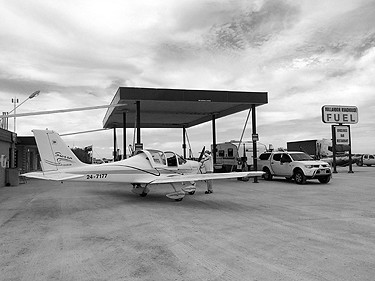
Trucks, travel trailers and even an airplane line up at the pumps of Australia's Nullarbor Roadhouse. Photo by S. Kirchman
The View from Rockfish Gap
Photos by Bob Kirchman
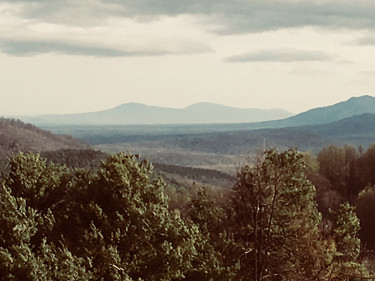
Massanutten Mountain as seen from Rockfish Gap.

A foggy rainy morning, Rockfish Gap.
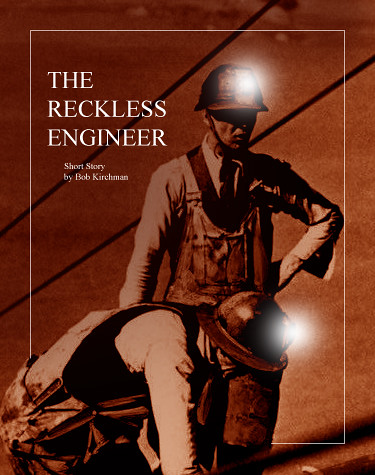
A Vision Takes Shape...
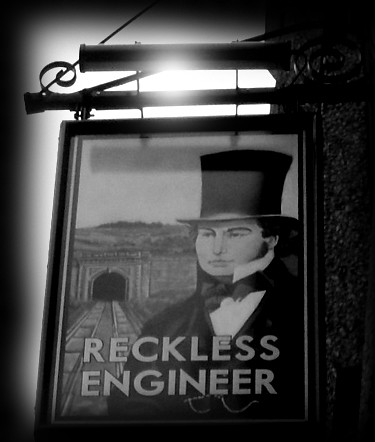
The Reckless Engineer
Short Story by Bob Kirchman
And all the people without dreams
Oh they laughed and oh they mocked in vain
You never needed monuments
Look at the Cornish sky and Bristol gorges”
-- Coast, ‘The Reckless Engineer’
Better drink up” the bartender said. “This is the last pub in the Western Hemisphere. Diomedes are dry and there’s only cheap vodka for 2000 miles after that.” The young couple, who were staying at the hotel complex in Wales, AK, were anxious about the next phase of their ‘Around the World’ tour. There was only an older gentleman sitting there with them in a corner of the room… nursing a gin and tonic as he sat musing. “He might be able to tell us,” the young woman opined.
Sure enough, the question as to the unusual name of the establishment caught his attention.
The Reckless Engineer... hmmmm, where do I begin. Well, the reference is to a gentleman who lived in the Nineteenth Century. He was Isambard Kingdom Brunel. Most people in the New World don’t have a clue, but the Brits revere him. He basically built the modern infrastructure of a great empire… railroads, tunnels, bridges, and great ocean-going ships! But it was a tunnel that almost killed him before his time.”
His father, Mark Brunel was a French expat and an inventor. He came up with a method of tunneling underwater and set to work to prove it by tunneling under the Thames. It still exists. It is part of the London Underground, but it was a daring move in the day it was built. The biggest problem was the uncertain composition of the earth under the river. It had been dredged and had unmapped holes in it. The younger Brunel was in charge of a crew excavating the bore and when water rushed into the tunnel, he was almost swept to a certain death. His assistant, a Mr. Beamish, plucked the young man to safety. Several colleagues who were with him were not so fortunate. They drowned in the rush of river water and sewage that flooded the tunnel.
Young Isambard went to the seacoast city of Bristol to recuperate. But he was not the sort to relax on holiday so he entered a competition to design a bridge to span the Avon Gorge there. Mind you, he’d never designed a bridge in his life, but he came up with several beautiful renderings for a suspension bridge over the gorge. Britain’s great engineer, Thomas Telford was to judge the contest. He rejected all of the entries and supmitted his own proposal. The people of Bristol hated it. In the end, Brunel’s beautiful design was chosen. The gorge was high and Brunel built a cable ferry to transport men and materials across it. Once when the basket snagged on the cable, young Isambard climbed out of the basket and hung precariously while he freed the mechanism. There is a pub in Bristol by the railway station that was the first to be named ‘The Reckless Engineer.’”
But why is this place, at the end of the world, also named ‘The Reckless Engineer’?” the young woman asked.
The Twenty-first Century was not so much unlike the Nineteenth,” the old man said. “After a period of great prosperity followed by great uncertainty, another engineer, perhaps not so young stood on the coast of Wales here, about to embark on the project that linked two continents. I’ll tell you a secret… HE’d never designed a bridge either. His Daughter and her husband provided most of the brain power for the actual design. The team of O’Malley and O’Malley are the real force behind the great bridge. Rupert Zimmerman was more of a showman. He convinced investors to back what was then a rather audacious undertaking. His daughter Elizabeth created beautiful renderings following the design laid out by her more practical husband.
And so, camped on the shore right where this hotel stands, Zimmerman and Martin O’Malley camped to survey the scene of their great work. If you go to the cheesy ‘Rupert Zimmerman Museum’ here in Wales, they’ll tell you how they heroically survived a fire that destroyed their tent and their provisions. They used their survival training to last the week there and returned to Nome as something of a sensation… but that is not the true story. O’Malley and Zimmerman stood on the shore of the Strait, drinking prodigious quantities of their favorite beer as they toasted their new venture.
They decided to go for a swim in the Strait. They didn’t think about how cold the water was and when they fumbled to build a fire they succeeded in burning up their tent!”
So, what about the part about him being in the war and all… what really happened there?”
Well, he really did lose a leg fighting in the battle of Anchorage and he went to Nome to recuperate. He idea for the great bridge came to him there and as his daughter came to Nome to care for him, she really did meet and marry O’Malley. They get that part right.”
And the part about him riding out the great storm on the partially built span?”
True as well, but I think Zimmerman really believed in the cable anchoring system and the pontoon span’s integrity. Soon enough the motoring public would be trusting the same system… not really as heroic as they make it out to be.”
And his childhood, hopping freight trains and all…”
Can’t deny it. I don’t think he was as brave as they make him out to be. Still, we’d all agree that he had a pretty amazing life.”
So, what’s next for him. The bridge just opened this past November. Now you can actually drive to Isambard Kingdom Brunel’s England on a highway. What does a man like that do… I guess he can retire and take life easy. Say, is it true that Brunel and Zimmerman were both short in stature and somehow driven by insecurity about it?”
I can’t speak personally for Brunel but I think you pretty well nailed it.”
The night passed quickly. The old man was a repository for so much information about the bridge and its construction. But he asked the young couple to tell their story as well. They somewhat nervously said that they had decided to embark on this adventure but that they had applied to the School of Engineering and Operations run by the Zimmerman organization in Wales. “I doubt if we have a shot at it, but we had to give it a try.” the young woman added. We met at Virginia Tech and discovered that we were more like this Brunel… reckless and all, than most of our colleagues. Sir, are you familiar at all with the school here?”
Oh, I know a thing or two about it.” The old man replied.
Is it true that they went back to the old bench-test and physical model methods from the old U.S. Space Program?” “Yes, it is true, and when you are there you will study these methods as well.”
The evening was growing late. The young woman remarked that she wished it possible that they could somehow find a way to get a ‘hard hat’ tour of the new biosphere being built on Big Diomede the next morning. “We’re staying here several days.” I don’t know who would be able to arrange that. If we could afford it, we’d be happy to pay.”
The old man wrote a phone number on a cocktail napkin and handed it to her. “Call this number in the morning, and depending on how long you are here for, you could see the new biosphere and some of the inner workings of the bridge as well.”
Oh, thank you so much! We’ll call first thing in the morning. You know we’d love to see as much as they are willing to show us! Say, who should we ask for, Mr… oh, I’m so sorry, I never learned YOUR name?”
Rupert,” the man responded, “Rupert Zimmerman, and I am quite pleased to meet you both.”
*********
You built the railroads from the West
You built the ships from iron ore and
All of your bridges never rest
But without love they're nothing more”
-- Coast, ‘The Reckless Engineer’
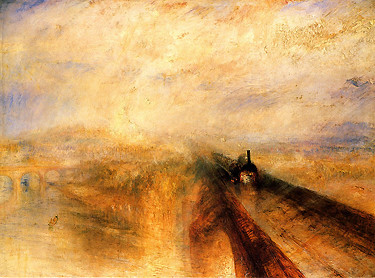
Rain, Steam and Speed - The Great Western Railway, by J. M. W. Turner. 1843
John and Alana (for that is the young couple’s names) arrived early the next morning at the offices of the Zimmerman Organization high in a tower overlooking the Strait. They were ushered into the reception area by a lovely young lady who had a distinct sparkle in her mischievous green eyes. “Hello, I’m Hannah,” she greeted them. “Mr. Zimmerman will be with you momentarily, but would you like some coffee?” “Uh, sure,” the young couple responded as Rupert’s receptionist zipped around the corner of her ample desk, grabbed a tray and dispensed their choices of beverage and placed it on a table by their chairs.
Please excuse my zipping about. My ‘Bionic’ leggings are being retuned today so I’m back in the chair for a bit. If you’d like, we could show you a bit of the research lab before you take the grand tour.” Alana’s eyes grew wide. “I’ve heard many amazing things about the lab. I would LOVE to see it!” She remembered the wonderful story of how Alexander Graham Bell had begun his research with the effort to give sound to the deaf. Here in the remotest part of the world, his legacy continued. “The lady who developed the assistive leggings and I work closely together,” said Hannah. “What is really cool is how they are truly assistive. They do nothing FOR me, but rather provide a little extra steam and steadiness to MY walking. You will see some amazing things happening here… artificial sight for the blind, direct transfer of sound to nerves, and a whole new level of prosthetics.”
We would love to see as much as you are willing to show us,” said John, “We are in no great hurry to venture off into Siberia.”
Good,” because we have three days worth of tour if you’d like it!”
This is what I call the ‘Labyrinth of Exile’” Zimmerman began as they walked through the tower’s endless corridors. “It’s named after a biography of Theodor Herzl, Father of the modern state of Israel, from where many of our brightest researchers hail from.” Indeed the small nation was well represented, as was most of the rest of the world in the serious faces that greeted them over the course of the next three hours. Zimmerman was clearly delighted to introduce every one of them, like the cherished family he considered them to be. “Don’t make the mistake of thinking me any less than the tough old bird you’ve heard me to be. I crack the whip around here!” “Yes Papa, you do,” said a young woman in white coveralls and a hard hat. She had slipped up behind them, placing herself deliberately behind the old man’s back… he feigned displeasure at her looking over his shoulder, but his face betrayed a deep love for the young lady.
Well, I suppose you should meet my GRANDDAUGHTER,” he said somewhat in a feigned disparaging way. “She will be with us tomorrow when we tour the great bridge, but today I wonder if she would be willing to show you our design rooms?”
On the boards were two great designs for covered entrances to the great bridge. If the bridge was spare and functional, the approach covers were anything but. They were drawn in the style of Santiago Calatrava, the great bridge architect. Zimmerman called them “Paddington Station” and “Temple Meade” after the great trainsheds of Nineteenth Century designer Isambard Kingdom Brunel. “We sort of specialize in ‘reckless engineering’ here,” he said. Zimmerman’s granddaughter chimed in: “Calatrava’s genius was that he saw the design disciplines as one and that the wonder of living things could guide you in it. Papa sent me to study under him for a while.”
Calatrava built bridges, buildings, even children’s toys, but his mind was the same in all of these disciplines. Nature, if you were quiet and observed it, was your true teacher.”
*********
All of the Reckless Engineer has gone And where now does heart and soul beat in the city sky?”
-- Coast, ‘The Reckless Engineer’
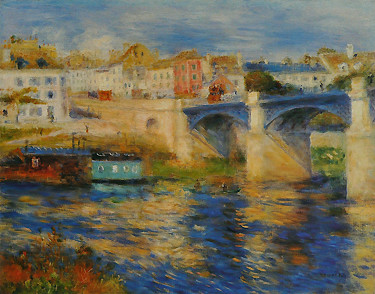
Le Pont de Chatou, Pierre Auguste Renoir
A bridge is a complex machine… or perhaps more like a living organism in that it moves and needs to be constantly renewed,” Rupert said as the little group entered the service stairway down into one of the great span’s floating piers. “In the Twentieth Century, great public works were authorized, heavily funded by the U. S. Federal government. In fact, they had a 90% match to 10% state funds. They did think of maintenance, it was supposed to have been funded by fuel taxes… but with the initial outlay for the bridges being so relatively cheap, it became all too easy for politicians to divert the funds that were supposed to be allocated for ongoing maintenance.
Fifty years after the great interstate highways were begun, an appalling percentage of the bridges on it were in questionable condition. Some of them actually failed outright.”
Alana and John soaked in the vast history of modern bridge building. Surely it was comforting to know that the operators of this bridge had learned some lessons from the past. Their tour had begun on the next morning… Saturday, but since they were on the International Date Line, the designation on operations calendars was Saturday/Sunday. Zimmerman had met them at the operations tower, beginning with the scores of monitor screens that allowed operations technicians to watch over the workings of Zimmerman’s ‘Darling Bridge,’ as he called it. That was a reference to Brunel’s affection for the Clifton Gorge span more than an infatuation of Rupert’s however.
Where is Hannah?” Alana asked? “Oh,” said Rupert, “She’s off today, but I suspect we’ll see her when we stop for lunch at the Big Diomede site.” I think she was going to paint landscapes with Mrs. Greene after church there today if the weather was nice.”
Sure enough, after a morning of ascending and descending into towers, piers and passageways, the entourage emerged on the large island in the middle of the strait to a balmy afternoon. The brief tundra flower explosion was brightly covering the wild plateau of Big Diomede and there overlooking the colorful display and the sea beyond, two women stood at easels painting en plein air. They looked like a Renoir painting themselves standing upon the verdant island. The wildness of this place dwarfed even the massive biosphere dome under construction. There was a raw beauty to this place and the timeless figures who painted it only added to its mystique. Under the freshly constructed dome a small lone house rose. Workmen were putting the finishing touches on it.
Rather than eat at the service plaza, I thought we’d prepare a nice picnic supper,” Mrs. Greene said after introductions. They were soon joined by Reverend Greene and Elizabeth Zimmerman O’Malley, Rupert’s daughter. It seemed like a fine Southern ‘dinner on the grounds,’ which indeed it was the remnants of, as it was Sunday on Big Diomede and the little church that met in the service plaza meeting room had indeed enjoyed such a feast earlier in the day. It was like a warm breeze from another Century… indeed even the driven Zimmerman seemed to slow down for it. John was impressed: “I did not expect food like I grew up on in… SIBERIA!” he exclaimed as he enjoyed a portion of macaroni and cheese that gained him a scornful glance from Alana, the health nut. But even she was obviously reveling in a bit of home so far from home.
Tomorrow I will give you the full tour.” Said Elizabeth, but today we will continue on with the inner workings of the great bridge. “Tonight,” Hannah said, “I would love for you to be my dinner guests at my condo in Wales. Would you?”
The day ended with the sun low in the sky and the last descent into a bridge pier where Rupert opened a hatch. His granddaughter smiled: “You’re showing them the fishing spot!” she happily exclaimed. Indeed they found rods and a small catwalk outside the hatch where they cast for some nice ocean fish. “We’ll cook them up at Hannah’s place,” Rupert said. “But I’m afraid I won’t be able to join you as this blasted cell phone is now giving me the message that we have an issue with the bridge seals in sector 217. I’m afraid I’ll have to set up a work zone tonight.
Indeed the dinner group shrunk to John, Alana, Elizabeth and Hannah. As they gathered in her condominium, Elizabeth took a call. The work on the seals was going badly. She excused herself. “My father will kill himself for his ‘darling bridge’ if I don’t go out to take some of the load off. Thankfully some of his senior guys have his back and call me like this.”
Tell me about the biosphere,” said Alana. “I just KNOW there is a story behind it.” Hannah looked about, walked over to her door and locked it. Slowly and deliberately she began: “When Mr. Z started this project, he was a pretty brash, no nonsense sort of ruthless industrialist. He ‘reaped where others sowed’ if you know what I mean. There is something you guys need to know about him. You’re in the program by the way, just don’t breath a word to HIM. I know though… I saw the look of satisfaction on his face when we met the relamping crew on the bridge. Alana, when you did not hesitate to climb up with the bulb… the man was one short, remember… you sealed your fate. I daresay the offer will be coming tomorrow.”
Hannah continued:
Zimmerman is a tough old bird, he fought in the battle of Anchorage and all, but when he began this great work people began to see another side of him. There was a young engineer and surveyor that he took under his wing. They went out to Siberia to lay out the road and discovered that it was like the Wild West out there. Trucks that broke down or wrecked by the side of the road were left there. After the local bandits looted them they set them on fire. Rusted and burning hulks were everywhere.
By the time you could get a recovery truck out there, the deed had already been done. The bandits would pull a driver out of his truck if it stopped out there and kill him.
Well, Mr. Z and this other young man were camped out there with plenty of guards… or so they thought, when they were ambushed and kidnapped. The bandits managed to pick off their security people. They took Mr. Z and his friend captive, knowing there would be big ransom money. When they missed Elizabeth’s frantic response and thought the money was being stalled, they took the young man away. That was the last time Mr. Z saw him alive.
The ransom money finally came and Mr. Z. was returned. When he returned to Wales he immediately organized a group of Alaska National Guard and they travelled back disguised as a road crew. When they got back to the site of the ambush, they discovered that the body of the younger man had been found in a cheap motel room in a trailer motel that was… well… not a nice place. The body was stripped and smelled of vodka. Rupert er I mean Mr. Z knew the man never drank. He was enraged that the perpetrators would sink to creating a sordid story. Zimmerman knew the man’s wife and children.
That was the only time I ever saw Rupert cry, and he wept unashamedly. I knew then that a man I had thought so cold and aloof loved deeply. He could be moved to tears by the loss of a cherished colleague.
He composed himself pretty quickly, however. His men could not get the local authorities to help them find the killers so in the end, in his great anger, he ordered everyone out of the motel buildings at gunpoint and soaked the place with petrol. Then he burned it to the ground. He returned to Wales visibly shaken but back to his old aloof self. He set up a trust for his friend’s widow and children and spoke at the memorial service of his fine service. But he was holding something inside that he couldn’t let go.
The flashbacks returned from his war days. Everyone thinks the reason he’s estranged from his wife Pat is that she doesn’t like cold places. The truth is he wakes up screaming… and he won’t seek help for it. He visits her regularly in Virginia but the truth is HE doesn’t want her here when he falls apart. He won’t let go of his anger and sorrow. I fear it is going to kill him one day!
The biosphere you saw today… its more than an environmental experiment… It is largely the creation of Elizabeth, but you must know that it is Rupert’s true ‘darling’ in that he sees it as an antidote to the “Hell on Wheels” he found across the strait. He claims to have no faith… that pretty much went away in his childhood he says. He ‘survived’ indoctrination by the ‘Sisters of Mercy.’ He says they showed none.
But he knew that his biosphere would be nothing more than glass and steel if it did not have some sort of a soul. That is why he convinced the Greenes to come up here. If you didn’t notice before, see how he lets down his guard in their hospitality. Tomorrow you must see the renderings Elizabeth and Mrs. Greene have prepared for the biosphere. These are not the works of one who merely desires austere efficiency.
I really don’t know why I am telling you all this, but I sense that you may indeed be in a position to help him. He allows Elizabeth and his granddaughter to come closer, but I feel like he’s a clock wound too tight… and working in two concurrent times, I fear he’s going to break!”

Summer Landscape, Pierre Auguste Renoir
*********
I am opposed to the laying down of rules or conditions to be observed in the construction of bridges lest the progress of improvement tomorrow might be embarrassed or shackled by recording or registering as law the prejudices or errors of today.”
-- Isambard K. Brunel
Sunday/Monday dawned early. Hannah greeted John and Alana at Zimmerman headquarters. “Elizabeth will be here in a bit,” she said. “Long night with the bridge seals!” A bleary-eyed Rupert popped out of his office: “How was dinner?” he asked.
Quite nice,” Alana responded, “And how did the work go on the seal problem?”
Zimmerman explained the seal problem… it seems that sustained temperatures combined with heavier stressed connections was taking more of a toll on them than anticipated. “Say John, you’re a materials guy. Would you look at this tech brief and when you get back here this Fall, would you like to have a go at it?”
Does that mean we’ve been accepted for the program then?” He responded. “Sure. Let me read this tonight. My thesis was on something similar with flexible pipe couplings. Maybe we can find a way to take some of the stress off of the seal itself in the meantime.”
I like that,” said Rupert. “Most guys just start wanting to remake the seal material straight off. You seem to have another tack. Tell me more.”
Well, sir, it seems the problem is exacerbated by the movement in the bridge. If we could add some sort of a stiffener, we could spread the stress better. I mean, you seem to be experiencing very localized failures at places the bridge moves more than others.”
So, in the minutes before Elizabeth arrived, the young couple had sketched out a pretty interesting clamping system that would spread the flexing evenly along the length of the span. Zimmerman was visibly impressed. “Hey, we could talk about this with your team tomorrow if you’d like.” Alana said. “That is, if you wouldn’t mind.”
When Elizabeth arrived, the congratulations were officially offered. Alana and John would sign on as mentees for their first year. They would be given accommodations and a small stipend until their year-end review, when they would likely be looking at $100K in petrodollars each per year starting salary. Of course, if the seal relief system played out, they would be receiving a bonus for that. Zimmerman, who had seen plenty of his ideas taken by employers with no attribution, had no problem sharing the glory when his own team, even the mentees, made valuable contributions.
But now it was time to head over out to Big Diomede, a half-hour drive West on the bridge. Elizabeth drove John and Alana across the span… but she spoke little. She was tired, sure, but clearly something was on her mind. “I’ve never seen someone get accepted so quickly,” she mused quietly. “You know, John, you remind me of…” she caught herself and was silent for the remainder of the trip. It seemed a long half-hour indeed and when the car finally reached the Big Diomede site, everyone was relieved when Mrs. Greene greeted them. She had worked with Elizabeth in the creation of the Biosphere and sure enough, the renderings of the proposed complex were stunning. It was something out of another Century so far as its craftsmanship and execution. The parsonage was the only building built so far, but it was simple and beautiful; quite a contrast to the prefabricated world of Wales. A lone tree, freshly planted, graced the yard. Nearby there was a footer where stonemasons were laying the first course of a more substantial building. Elizabeth pointed to a painting of a gothic chapel… “A memorial to a man who lost his life in the service of the Zimmerman Organization,” said Mrs. Greene. “The chapel will be home to our church here.”
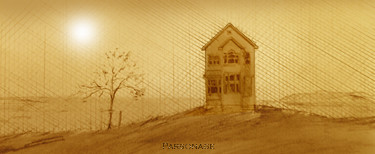
The biosphere was a fascinating place. Artificial sun-spectrum lighting was being installed along the bars of the geodesic dome which had ionized panels that could be clear for natural light but could be clouded to reflect the light from the lamps down. Huge rigs were drilling down to provide thermal heating. Nursery workers were planting quick growing shrubbery to provide air refreshment inside.
At lunchtime, the Greene’s again hosted what Mrs. Greene referred to as ‘Elevensies.’ This time in their newly finished dining room. “Tell me about the man who the chapel memorializes,” Alana said to Kris Greene as John and Elizabeth were in deep discussion of geothermal piping following their delicious lunch. “Oh,” said Kris, “I myself never knew him… but I understand he was a close friend of Rupert’s. They were working on the Great Western Road alignment in Siberia, I think, when…” Elizabeth interrupted: “I think we’d better get on with our tour now. Thank you, Kris, for your warm hospitality.”
Back at Wales, Elizabeth was summoned by her cell phone… the bridge never ceased to call on her keepers, it seemed. She apologized for her demeanor. “Rough day, it has been,” she said. Hannah was there, eager to show the young couple some of the photos on the wall in the lobby. “Here is the place where we were drilling for oil, but Rupert discovered that the people were all sick for lack of water. Well, he threw a curve-ball into the calculations for the lateral drill. When it gushed not oil, but fresh water, his crew groaned at his ‘mistake,’ but when he capped it the people had a good and steady supply of safe water. Everyone here sort of goes along with the legend that he’s a real cheapskate… but you did see the beginnings of the Big Diomede Chapel, didn’t you. That is not a shabby piece of work at all.”
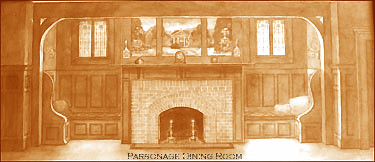
Rendering by Lola Dalton, 1914, the Author's Grandmother.
Alana spoke: “Do you mind if I ask you, ah, about Mrs. O’Malley; what is it that is troubling her? When we were accepted, I mean, it seemed she has some great reservations or something. Look, we don’t want to come here if you have any doubt that is sincerely based.” Hannah thoughtfully replied: “This is not the time or place, but please come to my place tonight and we’ll talk further. My husband is in the ‘lower 48’ representing our interests in Washington, a thankless part of his job. I’ll be glad when he’s done, but in the meantime it would be wonderful to have some company!”
We don’t say his name here,” Hannah said softly… “Rupert’s colleague who died in the Taiga, but it is clear that he… and his daughter Elizabeth, see the resemblance. He was young, reckless and would go to the ends of the earth… but he had a young family. I would imagine Elizabeth sees her father performing penance, if you will, for the death of his trusted friend. Oh, don’t sweat that. I’ve reviewed your qualifications. You are more than what we require in every way, but I think you will have to deal with the fact that Rupert sees in you an unfinished life. He’s not going to go easy on you, mind you, his granddaughter is the apple of his eye, but he rode her harder than the rest of them. I do not think Elizabeth’s unspoken fears are rational, but fears seldom are.”
So, what shall we do?,” Alana asked.
I don’t know, really, but I suspect that in time this will prove to be a good thing. You came here prepared to be patient, and the present situation requires plenty of that. Elizabeth is quite protective of her father, and I think she has good reason, but she is fair minded. I think you will prove yourself in the end and you will find her a lovely person to work with. In the meantime, I think it best to avoid discussion of a certain unfortunate occurrence… and of Rupert’s attempt to remember it.”
Rupert Zimmerman awoke that night screaming. He came to himself in a cold sweat and got up and checked the lock on his door. His was the top apartment in the condominiums over the workspaces and Elizabeth and Martin were directly below. He hoped he hadn’t disturbed them, but he knew full well that he had. He didn’t know that Hannah’s apartment, though it was further away, allowed her to be disturbed as well. Rupert Zimmerman was a man who professed no need for the Divine… but in the endless night, as Rupert raised the blinds in the hopes that the midnight sun would free him from his prison, his daughter, son-in-law and his devoted assistant prayed to the God Rupert spurned. Back in Virginia, Pat couldn’t sleep. Rupert weighed heavily on her mind. Thirty miles away from Wales, as a new day began at the end of the world, a young woman took her husband’s hand to pray as well: “I’m concerned for Elizabeth’s father.” She prayed. Though Zimmerman would have scoffed at the very notion, his friends that moment were speaking in unison to that God, pleading for the deliverance that only He could give.
If we must have heroes and wars wherein to make them, there is no war so brilliant as a war with the wrong, no hero so fit to be sung, as he who has gained the bloodless VICTORY of truth and mercy."
-- I. K. Brunel
(the Reckless Engineer is the Prelude to PONTIFUS [6.])
Copyright © 2017, The Kirchman Studio, all rights reserved
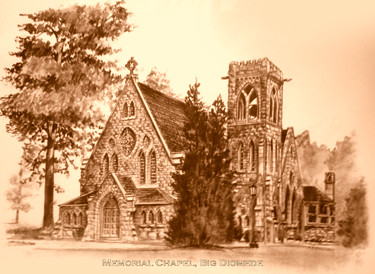
PONTIFUS, The Bridge Builder's Tale
[click to read]
The History of Serial Fiction
Serials have existed in fiction for a very long time. Books were expensive back in the 19th century, so they were printed in installments in order to keep the price low. Charles Dickens, often heralded as one of the greatest early self-publishers, was also one of the most successful writers of serialized fiction. Another big name, Alexandre Dumas, was a very prolific serial novelist, publishing both The Count of Monte Cristo and The Three Musketeers in serial format. In fact, serialization worked so well, it was considered the way to go by popular authors during the time." -- Samantha Warren
THYME Magazine presents, in serial form, the story of a man who challenged the proposition that something he wanted to achieve was "impossible." Based on history, depicted in the future, Pontifus is a tale of human triumph in the face of challenges such as face us today. (read more)
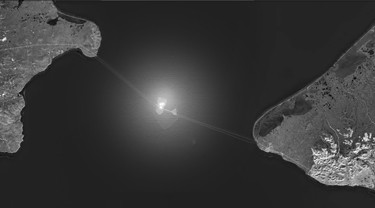
Sunlight reflects from the biosphere domes of Big Diomede in this photograph of the Bering Strait Bridge from space.
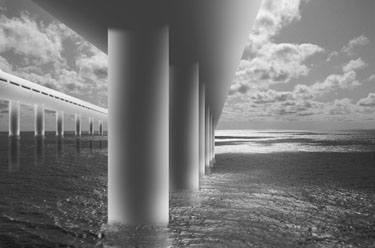
The twin spans of the Bering Strait Bridge. The original span (closest) is the Charles Alton Ellis Memorial Bridge. The second span is the Joseph Baermann Strauss Memorial Bridge.

The twin spans stretching to the West and Asia.
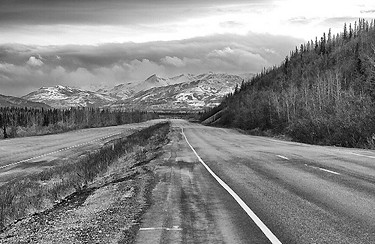
Alaska A2.
Copyright © 2017, The Kirchman Studio, all rights reserved
New 'Old' Architecture
The Inspiration for the Buildings of Big Diomede
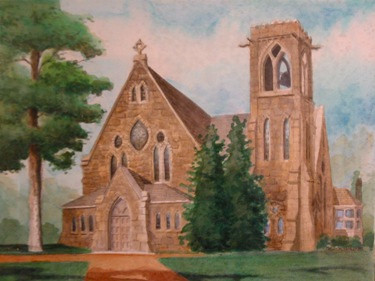
The Church on Big Diomede is based on my painting of the University of Virginia Chapel.

My Grandmother, Lola Dalton Carpenter, designed this window for a stairwell in 1914. I carried it into the Twenty-first Century as a window at the College on Big Diomede.
At the turn of the Century, as the Twentieth Century began, the great world's fairs presented a vision of civic architecture for America's young cities. A beautiful classicism prevailed, inspired by the model of Greek and Roman architecture. As the McMillan Plan transformed Washington DC into a very beautiful city, it put in place a sort of architectural order. The civic buildings of the metropolis all followed the form of Greek and Roman architecture. The great Cathedral and Catholic shrine rose in Gothic and Byzantine forms, thus creating a wonderful order for religious architecture as distinctive.
For Big Diomede, it seemed appropriate to again visit the past for ordering the future. Thus I returned to classicism for the College and Gothic for the Chapel, the precedent being Thomas Jefferson's University of Virginia... a beautiful campus in the Palladian style. Jefferson omitted a place of worship, perhaps by design, but in the 1880's a chapel Designed by Baltimore architect and University alumnus Charles Emmet Cassell was erected. The chapel’s materials, site, and style signify it as a Christian building in contrast to the Academical Village. Upon the chapel’s dedication, Professor Maximilian Schele de Vere proclaimed that while the Rotunda represented “in cold though classic beauty the outlines of a pagan temple,” the chapel aspired to Heaven with its “pointed window” and “flying buttress.”
In 1980 I was married to my beautiful wife in that chapel, about a century after it was first proposed. Thus that building is very special to me. The Zimmerman Stone Mountain Proposal Story is the story of my own proposal! Yes, the Divine sent a Storm! We like to think it would have happened anyway, without the Heavenly pyrotechnics, but it remains a great story.
Grandma's window and Inglenook found their way into the story simply because the images fit the mission, and I love them. She was a student at the Maryland Institute in 1914 and produced most of her work in those years. She married O. F. Carpenter, a successful Madison businessman and painted as an avocation until her eyesight failed in the 1970's. Lola Dalton Carpenter was extremely talented and had studied fashion design. In a later part of the story, yet to be told, a nod to Kris' efforts in this discipline is really a shout to Grandma, who all of us credit with our own creative impulses. My cousin in Oregon is an incredible photographer. My own children are very good too. We all thank Lola Dalton Carpenter for blazing the creative path for us!
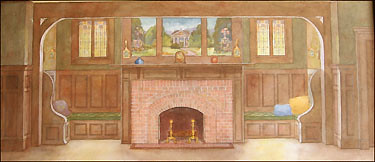
My Grandmother, Lola Dalton Carpenter, designed this ingelnook in 1914. Of course, it was exactly the look I wanted for Kris' house on Big Diomede.

I added the chalk drawings in front of one of my renderings to create the exterior.
Copyright © 2017, The Kirchman Studio, all rights reserved
The Reckless engineer, available at: www.coastrock.co.uk
